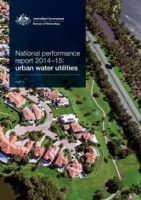Bureau reports on water utilities' performance
17/03/2016

The annual report comparing Australia's urban water utilities' pricing structures and service quality released today showed that the median annual volume of residential water supplied fell by three per cent in 2014-15 to 179 kL per property despite drier than usual conditions.
The National Performance Report 2014-15: urban water utilities details water resources, finance, pricing, assets, health, environment and customer numbers information collected from 80 water utilities and councils and seven bulk water suppliers.
The Bureau's Assistant Director Water Information Services Dr Ian Prosser said surface water remains the dominant source of water in Australia, but there was a 13 per cent increase in recycled water supplied by medium to large utilities, including many large regional utilities and councils.
"This increase reflects the reduced availability of surface water and the need to diversify supply sources in the face of growing demand. This year we have also seen an end of increases to national median water supply to residential properties, following the end of the millennium drought and the associated easing of water restrictions."
"This may be linked to temperatures in 2014-15 not being as extreme as previous years, although they were above average. The plateau in water use is positive for Australia," Dr Prosser said.
The national median typical residential bill for water and sewerage rose by four per cent in 2014–15, increasing to $1,299 in 2014–15 from $1,255 in 2013–14.
Australian urban water utilities spent $3.022 billion on water supply and sewerage services in 2014–15, a four per cent ($126 million) decrease from the previous year.
The median combined operating expenditure, on a dollar-per-property basis, fell five per cent to $850 per property in 2014–15, down from $892 in 2013–14.
Mr Adam Lovell, Executive Director Water Services Association of Australia (WSAA) welcomed the release of the National Performance Report and the continued transparency of the urban water industry through this type of robust and regular public reporting.
"Australia’s urban water sector is well trusted by the community, as demonstrated by the continued reduction in the national median for water and sewerage complaints. While utilities continue to focus on meeting customer and stakeholder needs they are also diversifying their supplies. With increases in the nationwide recycled water supplied, the industry continues to play an essential role in the productivity and liveability of our cities and regions. Utilities across Australia are also seeking to be more efficient as demonstrated by the decrease in the median operating costs per property of five per cent," he said.
This is the tenth annual national urban water performance report and the second released by the Bureau. The National Water Commission produced previous reports.
The report was prepared by the Bureau, the Water Services Association of Australia (WSAA) and state and territory governments. The independent and public nature of the report helps consumers and government determine whether the water sector is operating in an efficient and cost effective manner.
It contributes to the Bureau’s Improving Water Information Programme, which is building a comprehensive and reliable picture of Australia’s water resources to support policy and planning.
For more information: www.bom.gov.au/water/npr










